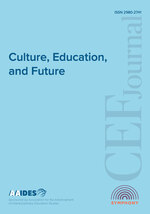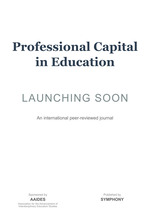Becoming ethically preoccupied through Currere: W.G. Sebald, Franz Kafka and narrative self-representation
DOI:
https://doi.org/10.70116/3065457236Keywords:
Currere, autobiography, melancholy, narrative, difficult subjectsAbstract
Within education, we can learn a great deal from others’ uses of narrative as a site of praxis from which to work through difficult psychic processes. The narratives published by W.G. Sebald and Franz Kafka—as well as what we know about these authors’ narrative processes—hold important insights for the kind of narrative writing that can happen in currere. Born in Germany near the end of WWII and inheriting the heavy burden of the Holocaust, Sebald was concerned with the social implications of writing as a form of witness, even as he was persuaded that a narrative approach was more powerful than discursive prose. Sebald saw in the writing of narrative an attempt at restitution. For Franz Kafka, the writing of literary texts offered the only space in which he experienced some redemption from (as he called it) “murderers’ row.” Despite their stature, both considered themselves as periphereal writers; writing came from a felt sense of precarity and vulnerability. Both relied on unreliable narrators. By exploring the relations between Sebald’s and Kafka’s writing lives and their melancholy, I inquire into how both were driven by a sense of urgency in writing narratively (one form of which is literature) and look at how such writing embodied an ethical probing of unsettling preoccupations, in ways of compelling interest to projects of subjective/social reconstruction.
Downloads
References
Anderson, M. M. (1992). Kafka’s clothes: Ornament and aestheticism in the Habsburg fin de siècle. Clarendon Press.
Anderson, M. M. (2003). The edge of darkness: On W. G. Sebald. October 106: 102-121. DOI: https://doi.org/10.1162/016228703322791043
Banki, L. (2023). Walter Benjamin. In U. Schütte (Ed.), W.G. Sebald in context (pp. 184-191). Cambridge University Press. DOI: https://doi.org/10.1017/9781009052313.022
Barthes, R. (2010). Camera lucida: Reflections on photography. Trans. Richard Howard. Hill & Wang.
Benjamin, W. (1969/2007). Franz Kafka: On the tenth anniversary of his death. In W. Benjamin, Illuminations (pp. 111-140), Ed. H. Arendt; Trans. H. Zohn. Schocken Books.
Burton, R. (2009/1621). The anatomy of melancholy. Ex-classics Project (Public Domain). https://www.exclassics.com/anatomy/anatomy1.pdf DOI: https://doi.org/10.1093/oseo/instance.00006619
Chambers, C. (1997). On taking my (own) love medicine: Memory work in writing and pedagogy. Journal of Curriculum Theorizing, 14(4), 14–21.
Deleuze, G., & Guattari, F. (1986). Kafka: Toward a minor literature. Trans. Dana Polan. University of Minnesota Press.
Duttlinger, C. (2022). Attention and distraction in modern German literature, thought, and culture. Oxford University Press. DOI: https://doi.org/10.1093/oso/9780192856302.001.0001
Fowler, L. (2006). A curriculum of difficulty: Narrative education in research and the practice of teaching. Peter Lang.
Greene, M. (1978). Landscapes of learning. Teachers College Press.
Grumet, M. (2004). My green robe: Scholae personae. In S. Weber & C. Mitchell (Eds.), Not just any dress: Narratives of memory, body and identity (pp. 89-98). Peter Lang.
Grumet, M. (2015). Toward a poor curriculum. In W. F. Pinar & M. R. Grumet, Toward a poor curriculum (pp. 84-112). Educator’s International Press.
Hutchinson, B. (2006). “Egg boxes stacked in a crate”: Narrative status and its implications. In S. Denham and M. R. McCulloch (Eds.), W. G. Sebald: History—Memory—Trauma (pp. 171-182). Walter de Gruyter. DOI: https://doi.org/10.1515/9783110201949.2.171
Hutchinson, B. (2022). On purpose: Interest, disinterest, and literature we can live by. Forum for Modern Language Studies, 58 (2), 137-152. DOI: https://doi.org/10.1093/fmls/cqac026
Kafka, F. (1946/1971). The burrow. In N. N. Glazer (Ed.), Franz Kafka: The complete stories (pp. 325-359). (W. & E. Muir, Trans.). Schocken. (Originally published 1946)
Kafka, F. (1997/2019a). The Castle. (J. A. Underwood, Trans.). Penguin. (Original translation 1997)
Kafka, F. (1994/2019b). The Trial. (I. Parry, Trans.). Penguin. (Original translation 1994)
Knausgaard, K. (2022, October 20). Why the novel matters. New Statesman. Retrieved September 23, 2023 from https://www.newstatesman.com/culture/books/2022/10/why-novel-matters-imperialism-absolute-karl-ove-knausgaard
Medin, D. L. (2010). Three sons: Franz Kafka and the fiction of J. M. Coetzee, Philip Roth, and W. G. Sebald. Northwestern University Press.
OED [Oxford English Dictionary]. (1973). The compact edition of the Oxford English Dictionary, Volume II, P-Z. Oxford.
Ozick, C. (1996). The posthumous sublime. New Republic 215 (25): 33-38.
Pawel, E. (1984). The nightmare of reason: A life of Franz Kafka. Farrar, Straus & Giroux.
Pinar, W. F. (1976/1994). The Trial (1976). In W. F. Pinar, Counterpoints, volume 2; Autobiography, politics and sexuality: Essays in curriculum theory (pp. 29-62). Peter Lang. (Essay originally published 1976)
Pinar, W.F. (2004). What is curriculum theory? Lawrence Erlbaum Associates.
Pinar, W. F. (2011). The character of curriculum studies: Bildung, currere, and the recurring question of the subject. Palgrave Macmillan. DOI: https://doi.org/10.1057/9781137015839_9
Pinar, W. F. (2023). A praxis of presence in curriculum theory: Advancing currere against cultural crises in education. Routledge. DOI: https://doi.org/10.4324/9781003212348
Schütte, U. (2010). Against Germanistik: W. G. Sebald’s critical essays. In J. Catling and R. Hibbitt (Eds.), Saturn’s moons: W.G. Sebald—A handbook (pp. 161-194). Legenda. DOI: https://doi.org/10.4324/9781315088433-7
Schütte, U. (2023a). Minor writing. In U. Schütte (Ed.), W.G. Sebald in context (pp. 156-167). Cambridge University Press. DOI: https://doi.org/10.1017/9781009052313.019
Schütte, U. (2023b). Polemics. In U. Schütte (Ed.), W.G. Sebald in context (pp. 210-221). Cambridge University Press. DOI: https://doi.org/10.1017/9781009052313.025
Sebald, W. G. (1972). The undiscover’d country: The death motif in Kafka’s Castle. Journal of European Studies, 2, 22-34. DOI: https://doi.org/10.1177/004724417200200102
Sebald, W. G. (1976). The law of ignominy: Authority, messianism and exile in The Castle. In F. Kuna (Ed.), On Kafka: Semi-centenary perspectives (pp. 42-58). Paul Elek.
Sebald, W. G. (1998). The Rings of Saturn. (M. Hulse, Trans.). New Directions.
Sebald, W. G. (1999). Vertigo. (M. Hulse, Trans.). New Directions.
Sebald, W. G. (2001). W. G. Sebald at 92nd Street Y, October 15, 2001 [reading from Austerlitz]. Youtube video retrieved June 8, 2024. https://www.youtube.com/watch?v=ccMCGjWLlhY
Sebald, W. G. (2006). An attempt at restitution. In W.G. Sebald, Campo Santo (pp. 206-215). (A. Bell, Trans.). Penguin Books.
Sheppard, R. (2010). The Sternheim years: W. G. Sebald’s Lehrjahre and Theatralische Sendung 1963-1973. In J. Catling and R. Hibbitt (Eds.), Saturn’s moons: W.G. Sebald—A handbook (pp. 42-108). Legenda. DOI: https://doi.org/10.4324/9781315088433-3
Singer, C. (2023). Auto-/biography. In U. Schütte (Ed.), W. G. Sebald in context (pp. 93-101). Cambridge University Press. DOI: https://doi.org/10.1017/9781009052313.012
Stach, R. (2013a). Kafka: The decisive years. Trans. Shelley Frisch. Princeton University Press. DOI: https://doi.org/10.1515/9780691233567
Stach, R. (2013b). Kafka: The years of insight. Trans. Shelley Frisch. Princeton University Press. DOI: https://doi.org/10.1515/9781400865451
Stach, R. (2017). Kafka: The early years. Trans. Shelley Frisch. Princeton University Press. DOI: https://doi.org/10.2307/j.ctv7h0tx4
Strong-Wilson, T. (2013). Waiting in the Grey Light: Nostalgia, trauma and currere in W.G. Sebald’s Austerlitz. In Strong-Wilson, T., Allnutt, S., Mitchell, C., & Pithouse, K. (Eds.), Productive remembering and social agency. Sense Publishers. DOI: https://doi.org/10.1007/978-94-6209-347-8_2
Strong-Wilson, T. (2015). Phantom traces: Exploring a Hermeneutical Approach to Autobiography in Curriculum Studies. Journal of Curriculum Studies 47 (5), 613-32. DOI: https://doi.org/10.1080/00220272.2015.1049298
Strong-Wilson, T. (2017). Following One’s Nose in Reading W.B. Sebald Allegorically: Currere and Invisible Subjects. Educational Theory, 67 (2), 153-71. DOI: https://doi.org/10.1111/edth.12232
Strong-Wilson, T. (2021). Teachers’ Ethical Self-encounters with Counter-Stories in the Classroom: From implicated to concerned subjects. Routledge. DOI: https://doi.org/10.4324/9781003001720
Strong-Wilson, T., Castro, R., Crichlow, W., & Yoder, A. (Eds.). (2023). Curricular and Architectural Encounters with W.G. Sebald: Unsettling complacency, Reconstructing subjectivity. Routledge. DOI: https://doi.org/10.4324/9781003302940
Thompson, P. (2023). Philosophical models. In U. Schütte (Ed.), W.G. Sebald in context (pp. 192-201). Cambridge University Press. DOI: https://doi.org/10.1017/9781009052313.023
Turner, G. (2010). At the university: W.G. Sebald in the classroom. In J. Catling and R. Hibbitt (Eds.), Saturn’s moons: W.G. Sebald—A handbook (pp. 109-142). Legenda. DOI: https://doi.org/10.4324/9781315088433-4
Zisselsberger, M. (2007). Melancholy longings: Sebald, Benjamin, and the image of Kafka. In L. Patt (Ed.), Searching for Sebald: Photography after W. G. Sebald (pp. 280-301). The Institute of Cultural Inquiry.
Downloads
Published
How to Cite
Issue
Section
License
Copyright (c) 2024 Symphony

This work is licensed under a Creative Commons Attribution 4.0 International License.










